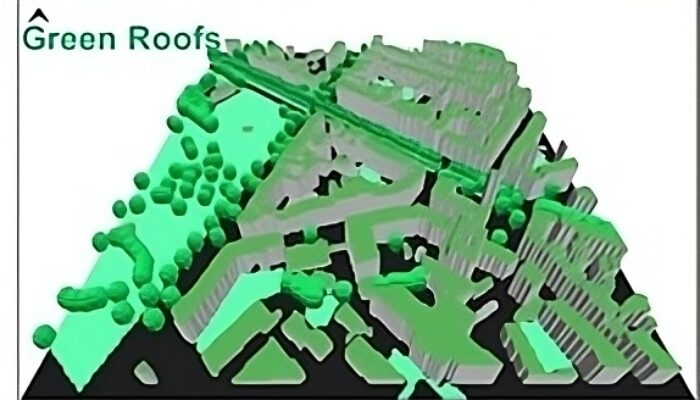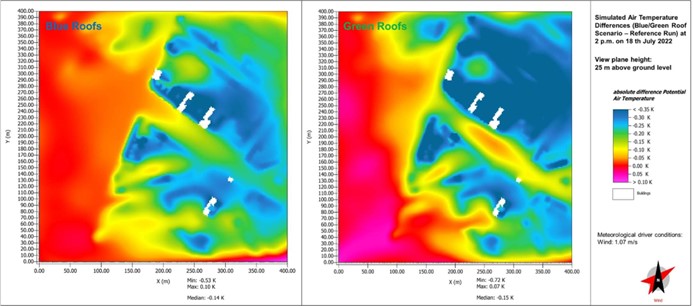
Urban areas often show higher temperatures than their surrounding rural areas, especially during heat events. This phenomenon is called the Urban Heat Island (UHI) effect. The magnitude of the UHI effect is expressed by the absolute temperature difference between the rural and the urban area and can reach more than 10 °C. During past decades, the magnitude of the UHI effect has intensified in many cities around the world. The UHI effect is mainly caused by a higher heat storage capacity of building materials and surface materials in urban environments in contrast to natural surfaces as well as by the reduced wind flow in urban areas due to its higher surface roughness. Furthermore, less solar radiation is reflected by urban surface materials. Due to the geometry of dense cities, especially the compact arrangement of high buildings and narrow street canyons, the sky view is highly reduced so that heat can hardly be emitted to the atmosphere as longwave-radiation and is captured. Thus, the UHI effect is most pronounced during nighttime, when cities cannot cool down and heat is stored in the built environment. Anthropogenic heat emission from sources like traffic or industry can additionally increase the magnitude of the UHI effect.
The spatial distribution of heat and the UHI magnitude is very heterogeneous within urban areas. For example, the temperature in a street canyon can strongly deviate from the thermal conditions in the inner courtyard of a building block, or between urban park areas and squares. The local conditions are therefore often described as microclimate. The high spatial variability of the urban microclimate can be traced back to the fact that many factors of the built environment directly affect their close-by surroundings. The most important factors are the color (termed as albedo) of materials, but also the wind ventilation of a place or the presence of vegetation and shadings. For example, temperatures are often higher in unventilated and unvegetated backyards, especially where dark surfaces are predominant. As a consequence of the intensifying UHI effect, many cities worldwide observe an increase in heat-related health issues and mortality rate.
Today, more than half of the world’s population resides in urban areas, a trend that is on the rise. Due to climate change, the magnitude of the UHI effect is also expected to further increase in future. Therefore, the linkage of global warming and ongoing urbanization and compression of cities will significantly increase the number of people being affected by the UHI effect. As not only the intensity of heat events is expected to increase in future, but also the frequency and duration of heat waves, heat stress is a major challenge for urban areas and needs to be addressed by urban planning and design. To reduce health risks and increase thermal comfort in future conditions, climate change adaptation measures are a key strategy to mitigate future heat stress. To improve both indoor and outdoor microclimatic conditions and thermal comfort, nature-based solutions like roof greenings or wet roofs are a promising approach as they do not require additional space in dense urban environments. However, cooling effects of such evaporation-based adaptation measures are limited by water availability to cool down urban environments during extreme or prolonged heat events. Water storage systems like rain-fed cisterns can supply water for roof greenings or wet roofs during hot periods, but also store storm water to reduce flooding risks. While individual green roofs or blue roofs only show small local cooling potentials in their direct surrounding of their installation, scaling such measures for a larger proportion of buildings can cause significant cooling effects for the entire city.
What we did:
To analyse the heat mitigation potentials of climate change adaptation measures, 3D physically-based models are used which can represent the real urban environment with a very high spatial resolution of up to 1 meter. Based on scenario analyses, pathways for climate change adaptation can then be implemented and simulated to identify changes in thermal conditions. In our research, we simulated the heat mitigation effects of blue and green roofs on building wall temperature and outdoor temperature by using the gridded microclimate model ENVI-met. This dynamic flow model can calculate energy transfer and mass transfer with a temporal resolution of 1 second to determine the microclimatic conditions within the study area. A 16-ha model domain of a dense urban district in the city of Cologne/Germany was parameterized using remote sensing data and field measurements to accurately represent the status-quo of the different urban surfaces, buildings and vegetation in the model domain (Figure 1a) (EINGRÜBER et al., 2023a). The accuracy of the model was checked based on a quality-controlled, densely-distributed microclimate measurement network with 59 sensors which was setup in the study area (EINGRÜBER et al., 2022). Scenario analyses were performed for a 20-year heat event in Cologne in July 2022 (EINGRÜBER et al., 2023c). In contrast to the reference run of the status-quo, green roofs were implemented on all buildings in the model domain in scenario 1 (Figure 1b), while newly-parameterized blue roofs were applied to all buildings in scenario 2 (Figure 1c).

Figure 1a: Reference Run: 3D ENVI-met model domain of the study area in Cologne/Germany (status-quo). Figure 1b: Scenario 1: Green Roofs (12 cm grass growing on a 16 cm loam substrate) on all building rooftop terraces (fully-irrigated). Figure 1c: Scenario 2: Blue Roofs (3 cm water bodies) on all building rooftop terraces.
Based on the model results, statistically significant average cooling effects of -0.52 °C and up to -2.67 °C on air temperature were found for blue roofs in relation to the reference run of the status-quo. For roof greenings, average cooling effects of -0.76 °C and up to -3.01 °C on air temperature were determined (Figure 2). The cooling effects show a high spatial variability within the study area. The highest cooling effects can be observed in inner courtyards of building blocks with less ventilation (Figure 3). Cooling effects of green roofs on outdoor air temperature are strongest during daytime, and for wet roofs strongest in the evenings. This can be explained by the transpiration of the vegetation and thus evaporative cooling during daytime which is much higher than the evaporation from blue roof water bodies, while plants fully stop photosynthesis-driven transpiration during nighttime without solar irradiation. Consequently, evaporation from blue roof water bodies is higher during nighttime than the reduced bare soil evaporation of the green roofs.

Figure 2: Average of air temperature 1m above rooftops in the model domain for the hottest hour of the day (4 p.m. at 19th July 2022).

Figure 3a: Absolute air temperature difference [in Kelvin] of the blue roof scenario in relation to the status-quo reference run.

Figure 4: Average of simulated building roof wall surface temperatures in the model domain. Comparison of the green roof scenario 1 and the blue roof scenario 2 with the status-quo reference run (grey).
More intensive roof greenings, for example, perennial plants, could show even stronger cooling effects than our implemented simple grass roof greenings. Sprayed wet roofs from a cistern pumping cycle could reduce wall heating during nighttime in contrast to our implemented standing water bodies. Overall, we conclude that green roofs and blue roofs are suitable climate change adaptation pathways and can serve as flood mitigation measures at the same time. Higher heat mitigation potentials are also expected when combining blue or green roofs with other technical- or nature-based solutions in street canyons like urban trees, grass grid paver unsealings or sun sails (EINGRÜBER et al., 2023b). However, our observed cooling effects are largely limited by water availability. Therefore, we compare the cooling effects of green roofs and blue roofs to a similar model setup for a monsoon-driven study area in Pune/India in ongoing research. Although the potential evaporation is much higher in India, the actual cooling effects are smaller than in Germany due to water scarcity in the Indian pre-monsoon hot season. Rain-fed systems like cisterns can rarely be operated for extreme heat waves at the hot season end in India. This demonstrated that climate change adaptation is of high relevance for future urban planning and needs to be researched individually based on the given local conditions and constraints. Microclimate modelling approaches like our performed scenario analyses are a powerful tool for assessing the suitability of adaptation measures in a local context to increase thermal outdoor comfort and reduce heat stress and mortality in urban areas in a changing climate.
References Eingrüber, N., Korres, W., Löhnert, U., and Schneider, K.: Investigation of the ENVI-met model sensitivity to different wind direction forcing data in a heterogeneous urban environment, Adv. Sci. Res., 20, 65– 71, https://doi.org/10.5194/asr-20-65-2023, 2023a. Eingrüber, N., Korres, W., and Schneider, K.: Microclimatic field measurements to support microclimatological modelling with ENVI-met for an urban study area in Cologne, Adv. Sci. Res., 19, 81– 90, https://doi.org/10.5194/asr-19-81-2022, 2022. Eingrüber, N., Domm, A., Korres, W., Löhnert, U., and Schneider, K.: Climate change adaption potentials of unsealing strategies in cities – An assessment during heat and drought events based on microclimatic simulations, EMS Annual Meeting 2023, Bratislava, Slovakia, 4–8 Sep 2023, EMS2023-525, https://doi.org/10.5194/ems2023-525, 2023b. Eingrüber, N., Schneider, K., and Korres, W.: Evaluation of microclimatic variations and adaptation effects in a central European city during the most excessive heat wave in summer 2022 by ENVI-met modelling, EGU General Assembly 2023, Vienna, Austria, 24–28 Apr 2023, EGU23-11806, https://doi.org/10.5194/egusphere-egu23-11806, 2023c.
This blog was edited by the CL editorial board.
